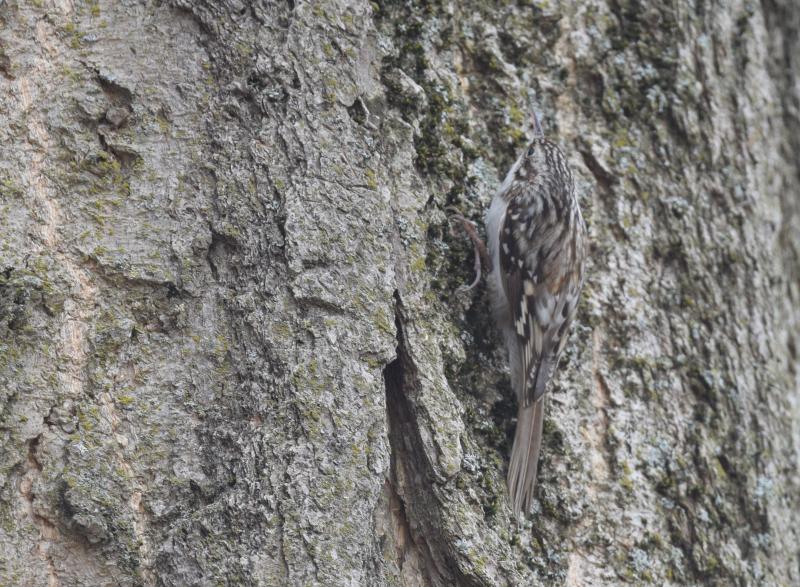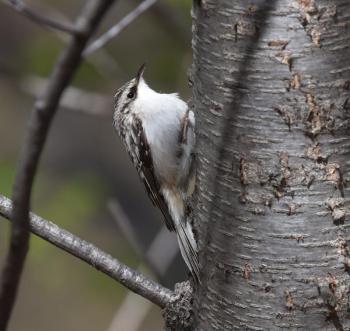A Mysterious Creeper of a Bird
Some birds are just inherently mysterious. Think of species that stay to themselves, rather than hang out in big garish flocks the crows and geese and ducks do. Or that hardly make a sound, or if they do, it’s a sound so soft and high that most people wouldn’t notice or just plain can’t hear it—unlike, say, the cardinal wakes us up with their exuberant early morning songs. Then there are the birds that do not have flashy, brightly colored plumage like orioles or tanagers but instead sport muted colors that camouflage them so well that it can be difficult to even see them. Finally, consider the species that don’t regularly come in to backyard bird feeding station and prefer habitats away from urban and suburban areas where most people live. Decidedly, pigeons, house sparrows, starlings are not among those inherently mysterious species.
One of the bird species that perhaps best fits into our characterization of inherently mysterious on all these counts is the brown creeper. Many Mainers who enjoy watching birds in the backyard have never seen one—some may not have even heard of the bird.
Mom Wells has had the good fortune having a brown creeper all winter coming in to feed on and below her suet feeder. Often the creeper picks up the scraps of suet dropped by woodpeckers and jays that hammer on the suet cake she has situated on a large ash tree in the yard. The size of the tree on which she has the suet feeder affixed may be the key to her success in drawing this secretive bird into her yard. That’s because brown creepers live virtually their entire lives hitching up the trunks of large, mature trees searching for insects and their eggs among the nooks and crannies of the bark. Small, smooth-barked trees just don’t have much for them in the way of food so brown creepers avoid young forests or places with only scattered trees. Brown creepers also nest under slabs of bark on dead and dying trees, which are most likely to be found in large, old forests.
The proximity of Mom Wells’ place to a large block of older forest is undoubtedly another reason that she has been able to enjoy daily visits of a brown creeper to her yard. Our neighborhood has no mature forest block close by, and we can count the number of visits by creepers to our yard over the years on one hand. When we have seen them here, it is typically during migration when one will move through the yard and perhaps check out the suet feeder for a few minutes before moving on.
Brown creepers are special enough birds that both of us can vividly remember the first one we ever identified. In our teenage, early birding years we each independently had the experience of quietly watching for birds in a forest when a high-pitched call made us look toward a nearby tree trunk. There, hitching up the tree was a little mouse of a bird, mottled brown and white on the head, back, wings and tail, and white underneath with a thin, down-curved bill and a white strip over the eye. We fumbled through the pages of our Peterson field guide and there it was in its unmistakable understated glory. It was so thrilling to find and be able to identify this mysterious bird at that time in our early birding lives.
And it’s still always special when we see one up close as we did recently during a COVID-distanced driveway visit to Mom Wells when her little creeper appeared in the middle of the conversation. Maybe one will “creep” up near you when you least expect a visit from this, one of Maine’s special and mysterious birds.
Jeffrey V. Wells, Ph.D., is a Fellow of the Cornell Lab of Ornithology and Vice President of Boreal Conservation for National Audubon. Dr. Wells is one of the nation's leading bird experts and conservation biologists and author of “Birder’s Conservation Handbook.” His grandfather, the late John Chase, was a columnist for the Boothbay Register for many years. Allison Childs Wells, formerly of the Cornell Lab of Ornithology, is a senior director at the Natural Resources Council of Maine, a nonprofit membership organization working statewide to protect the nature of Maine. Both are widely published natural history writers and are the authors of the popular books, “Maine’s Favorite Birds” (Tilbury House) and “Birds of Aruba, Bonaire, and Curaçao: A Site and Field Guide,” (Cornell University Press).
































